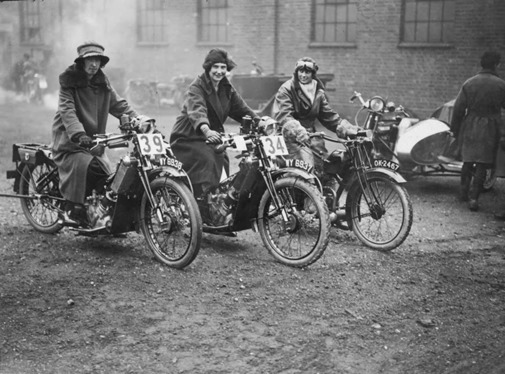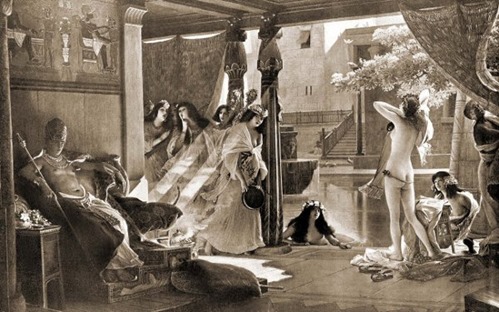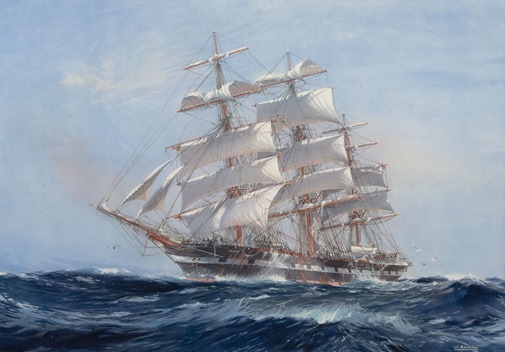The Sunday Comic – An Uncomplicated Illness
The Life & Times Of Aunt Mabel – Part 34
When it comes to offering a man a drink in an interesting way few woman have got a repertoire like aunt Mabel. She doesn’t even bother if the man in question is to plastered to hold the drink himself.
Should the man in question on the other hand have no interest in alcoholic beverages at all aunt Mable can easily take care of all the drinking herself. Here’s a picture from the modest gathering during her eleventh wedding.
The particular husband in question, Bertie, who had met Mable through an add she had put in a parish magazine just for the heck of it, was as you can see already beginning to have second thoughts.
That marriage, was by the way aunt Mabel’s personal record, it lasted a little under 6 days.
Filed under: Humour, Tackieness Tagged: Aunt Mabel, Drinking, Weddings
Needs No Intro……
…… needs no explanation
Filed under: Actresses, Movies, The fifties Tagged: 1953, Gentlemen Prefer Blondes, Marilyn Monroe
I Hate Elvis A Little Now……
…… quite much actually
Filed under: Actresses, Music, Photography, Rock'n'roll, The forties Tagged: Elvis Presley, Sophia Loren
Volkswagen SP2
Origins of the project
In the 70s, the Brazilian market was closed for imports. The only sports car officially made there was the aging (and by then retired) Volkswagen Karmann Ghia, and its failed successor, the Karmann Ghia TC. Only independent car makers were able to fill the gap, notably Puma, Santa Matilde and Miura.
"Project X"
The Volkswagen subsidiary in Brazil always had some degree of independence from Wolfsburg, so in 1969 they decided to start a new project of their own. A team led by Mr. Schiemann and supported by Rudolf Leiding (the CEO of the subsidiary and later of the entire company) started work on a so-called "Project X", and presented a prototype in a 1971 fair. But it would take another year before the car reached the streets.
Production models
The SP, the final name of the car, was built on the frame of a Variant, with the same Volkswagen air-cooled engine, but upgraded to 1700 cc, it developed 75 hp (56 kW), 160 km/h (100 mph) and made 10 L/100 km (28 mpg-imp; 24 mpg-US).
When the car was presented, it quickly drew media attention, with its many improvements over the local "air cooled" VW line, an impressive interior, its many extra features and its superb finishing.
Decline
A car named SP1 was also built, similar in almost every aspects but the engine, logo and a few trim items. However, due to its very poor performance (only 65 hp (48 kW) with a 1600 cc engine), it was soon discontinued, after 88 units. The same problem plagued the SP2. In fact, a malicious joke at that time was to relate the "SP2" name with "Sem Potência" ("Without Power", in Portuguese)
Despite its revolutionary look, the car failed to beat the Puma in performance. Although they used similar engines, the fiberglass Puma was much lighter. This resulted in low sales, and the SP was discontinued in February 1976.
With a total of 10,205 units made (670 of them exported, the majority 155 went to Nigeria with only one going to Europe, Portugal), the car is now sought-after as a valuable collector’s item. One of them, in white, is in the VW museum on public display. While prices during the production time frame were roughly the same as the Beetle, the price of a well-preserved example today is considerably higher than contemporary VW models.
P3
An attempt to resolve SP’s main problem, lack of engine power, was called "SP3 project". It would be basically an SP2, but with a 1.8L EA-827 (AP in Brazil) engine, water-cooled, 8,5:1, 100 cv SAE at 6000 rpm and twin carburetors, all "borrowed" from the Brazilian version of the Passat TS. Although nothing came of the factory project, a prototype was made by Dacon who also offered a (prohibitively expensive) conversion kit.
Text from Wikipedia
Filed under: Automobiles, The seventies, Transportation, Traveling Tagged: Brasilian cars, Sportscars, Volkswagen SP2
Jean-Jules-Antoine Lecomte du Nouÿ– French Orientalist
 Jean-Jules-Antoine Lecomte du Nouÿ (Paris 10 June 1842 – 19 February 1923 Paris) was an Orientalist French painter and sculptor. He was strongly influenced by the works and teachings of Charles Gleyre and Jean-Léon Gérôme. Lecomte du Nouÿ found inspiration for his art through extensive travels to Greece, Turkey, Egypt and Italy. The thematic content of Lecomte du Nouÿ’s work was mainly figural, but also spanned over a vast range of imagery throughout his career, including classical, historical and religious.
Jean-Jules-Antoine Lecomte du Nouÿ (Paris 10 June 1842 – 19 February 1923 Paris) was an Orientalist French painter and sculptor. He was strongly influenced by the works and teachings of Charles Gleyre and Jean-Léon Gérôme. Lecomte du Nouÿ found inspiration for his art through extensive travels to Greece, Turkey, Egypt and Italy. The thematic content of Lecomte du Nouÿ’s work was mainly figural, but also spanned over a vast range of imagery throughout his career, including classical, historical and religious.
Lecomte du Nouÿ is known for remaining faithful to his detailed, realistic style throughout the extent of his career, despite the onset of the Impressionist, Fauvist and Constructivist artistic movements during his lifetime. His work is said to have contributed significantly to the establishment of an iconic repertoire representing the Orient in the nineteenth century. A Parisian street was named after him in 1932.
Maturity and Travels
In 1865, Jean-Jules-Antoine accompanied fellow artist, Félix-Auguste Clément (fr), on his travels to Cairo, Egypt. It was after this voyage that the young Lecompte du Nouy sought to portray the opulence of the Orient. In later years, Jean continued his travels, visiting countries like Italy and Greece. Lecompte du Nouy found inspiration in all social, historical and literary facets of foreign culture.
Artistic Style
The Orientalist style is largely characterized by its content, but also by its subdued realism and precision allotted towards depicting the human form. The latter is a prominent characteristic of the 19th century methods upheld by the Académie des Beaux-Arts. Jean-Jules-Antoine was a prominent figure within the sphere of academic art and thereby would adhere to a rule-based artistic style of well-developed skill and formal composition. The artistic composition of Lecomte du Nouy’s paintings was often complemented by the use of half-light, which added certain dramatic and melancholic qualities to his work. To this day some, like Professor Alan Braddock, consider Jean-Jules-Antoine to have been decidedly modern for his time, because his work directly and indirectly broached some of the key issues of his day, albeit from a decidedly conservative perspective: colonialism, international trade, gender, religion, and history.
Text from Wikipedia
Filed under: Art, Article, Illustration, Paintings Tagged: French Orientalist painters, Jean-Jules-Antoine Lecomte du Nouÿ
Early Reckless Driver

Lieutenant-Commander Montague Grahame-White (racing driver, car, yacht & aeroplane broker), at the wheel of a Wolseley racing car with actor Julius Knight – c. September 23, 1902
Filed under: Automobiles, People, Photography Tagged: 1902, Lieutenant-Commander Montague Grahame-White, Wolseley racing cars
Chilling At The Gym
Patients using exercise machines at the Zander Institute in Stockholm, 1890s. Image courtesy of Tekniska Museet/National Museum of Science and Technology, Stockholm.
Dr. Gustav Zander founded the institute in the late nineteenth century and stocked it with twenty-seven of his custom-built machines. It was the first “gym” in the sense that we know the word today.
Filed under: People, Photography Tagged: 1890s, Exercise machine, Gyms, Stockholm, Tekniska museet, Zander Institute
Victorian Smut
The Barrison Sisters reveal kittens beneath their skirts, at the conclusion of their notorious vaudeville cat dance, c. 1890s
"In their most famous act, the sisters would dance, raising their skirts slightly above their knees, and ask the audience, "Would you like to see my pussy?" When they had coaxed the audience into an enthusiastic response, they would raise up their skirts, revealing that each sister was wearing underwear of their own manufacture that had a live kitten secured over the crotch."
From Wikipedia – Photo from Wikimedia
Filed under: Facts, People, Photography Tagged: 1890s, Barrison Sisters, The notorious vaudeville cat dance
The Warship That Inspired ‘The African Queen’ Still Going At 100
France 24 – International News – 19 February 2015
Written by Chris Oke & Erin Byrnes

© AFP / by Chris Oke, Erin Byrnes | The MV Liemba, a century old gunship gunship used during the reign of Kaiser Wilhelm II of Germany, seen in Lake Tanganyika, Tanzania
LAKE TANGYANIKA (TANZANIA) (AFP) -
On Lake Tanganyika, a century-old relic of World War I that became the stuff of Hollywood legend still plies the slate-grey waters — but it is not clear for how much longer.
Once a feared gunship defending the African lake for Kaiser Wilhelm II of Germany, the legendary vessel — which inspired the 1951 classic "The African Queen" — has been sunk and refloated twice, renamed and repurposed as a ferry.
As it marks 100 years of service, the MV Liemba, originally a symbol of colonial power, is now an essential lifeline for the people who live along the lakeshore.
"Liemba is the only safe means of transport along the lake," said Mathew Mathia Mwanjisi, the ship’s captain. "Historically it’s very important to Tanzania as a country, but again it’s very important for the people along the coast of Lake Tanganyika."
The tale of the warship and the battle for lake Tanganyika inspired British novelist C.S. Forester to write his 1935 novel "The African Queen", later adapted by Hollywood in the movie of the same name starring Humphrey Bogart and Katherine Hepburn.
Piled high with pineapples, maize and rice — as well as up to 600 passengers — the MV Liemba navigates the world’s longest lake every two weeks, from Kigoma, Tanzania, in the north to Mpulungu, Zambia, in the south.
The journey of some 600 kilometres (350 miles) is meant to take some three days, but is often longer as the ship hops from village to village, transforming into a lively aquatic carnival at each stop.
Children in leaky canoes paddle alongside to sell fresh mangos. Farmers and fishermen haggle over prices. Launches laden with revellers come to welcome newlyweds home.
In Context:
The African Queen is a 1951 adventure film adapted from the 1935 novel of the same name by C. S. Forester. The film was directed by John Huston and produced by Sam Spiegel and John Woolf. The screenplay was adapted by James Agee, John Huston, John Collier and Peter Viertel. It was photographed in Technicolor by Jack Cardiff and had a music score by Allan Gray. The film stars Humphrey Bogart (who won the Academy Award for Best Actor – his only Oscar), and Katharine Hepburn with Robert Morley, Peter Bull, Walter Gotell, Richard Marner and Theodore Bikel.
The African Queen has been selected for preservation in the United States National Film Registry in 1994, with the Library of Congress deeming it "culturally, historically or aesthetically significant". The film currently holds a 100% "Fresh" rating on Rotten Tomatoes, based on 37 reviews. The film led to an Academy Award for Best Actor awarded to Humphrey Bogart.
![a12077_ship1002 a12077_ship1002]()
Text and images from Wikipedia
Filed under: Article, Maritime history, Movies Tagged: Humphrey Bogart, Katherine Hepburn, Lake Tanganyika, MV Liemba, Tanzania, The African Queen, Zambia
![]()
The Sunday Comic – The Toothache
The Life & Times Of Aunt Mabel – Part 35
Aunt Mabel’s thirteenth husband Roderick owned a pub. Yeah, let that sink in for a moment. Mabel with free access to the bottles and barrels in a public house. Disaster you may think, and right you are.
Roderick, that poor sap, thought he had got himself both a cook and a barmaid. How could he know that the good looking  woman he had met in Kensington Gardens that bright and sunny Sunday in May had the capacity to drink his most alcoholic patrons under the table and that as cook she was among the few who could burn even water.
woman he had met in Kensington Gardens that bright and sunny Sunday in May had the capacity to drink his most alcoholic patrons under the table and that as cook she was among the few who could burn even water.
Mabel’s foul mouth, terrible temper and heavy swearing made her absolutely useless as a barmaid, even Roderick’s most faithful patrons began to find their pints and booze elsewhere. And the bub grub she cooked was left untouched even by the rats in the backyard where it eventually ended.
Besides poor Roderick would usually find Mabel dead drunk among empty bottles at one of the indoor tables or knocking down  pint after pint at one of the outdoor ones if the weather was good. There she would whistle at any man passing by, shouting indecent suggestions after them as they hurried down the street.
pint after pint at one of the outdoor ones if the weather was good. There she would whistle at any man passing by, shouting indecent suggestions after them as they hurried down the street.
Well, you should know our Mabel well enough by now, so you’ve probably already guessed that she was heading for another divorce fast. And right enough, poor Roderick had had enough of auntie after about 6 month. Not bad for Mabel really.
I must admit I sorely miss all that free booze Mabel later told young Johnny squeezing his bum playfully pressing her ample bosom teasingly against his arm, and she added, but that Roderick fellow was a right pillock. No fun what so ever.
Filed under: Humour, Tackieness Tagged: Aunt Mabel, Bubs, Drinnking, Public Houses
Women On Bikes

Madge Saunders and her husband, British comic actor Leslie Henson, 1920.

Sally Halterman, the first woman to be granted a license to operate a motorcycle in the District of Columbia, 1937.

An entrant in a ladies-only reliability trial in London, England, 1927.

Marjorie Cottle (second from left), a famous motorcyclist, and friends in Germany, 1920.

Three women riding motorbikes at the ACU Trials in Birmingham, England, 1923.

Nancy and Betty Debenham, well-known motorcyclists, riding BSA bikes with their dog, 1925.

Miss E. Foley and Miss L. Ball, entrants in the International Six Days Reliability Trials, at Brooklands race track in England, 1925.
Text and images from VintageEveryday
Filed under: Motorcycles, People, Photography, The thirties, The twenties, Transportation, Traveling Tagged: Female motorcycle riders, Madge Saunders, Marjorie Cottle, Miss E. Foley, Miss L. Ball, Nancy and Betty Debenham, Sally Halterman
An Uncomplicated Gentleman
Images found on: Ego is a rat on the sinking ship of being
Filed under: Lifestyle, People, Photography, Quotations Tagged: Age, Confessions
U.S. Revenue Cutter Guard
The USS Guard was a wooden hulled harbour craft built for the United States Revenue Cutter Service at the Mare Island Naval Shipyard in California.
She was launched October 20, 1913 and would be stationed at Friday Harbour, WA., and Seattle, WA.
She served in the U.S. Navy during World War I, returned to the Coast Guard in 1919; decommissioned and sold in 1943. Displacement 52 tons. 67’7” length, 12’6” beam, 6’3” draft. One triple-expansion steam engine, fitted for oil. Compliment of 10 men.
Text and image from AdventureOfTheBlackgang
Filed under: Facts, Maritime history, Transportation Tagged: Friday Harbor, The United States Revenue Cutter Service, USS Guard
Moving Aweigh- Popeye (1944)
In this classic animated short, Popeye and his friend Shorty get a telegram that Olive wants to move. They rent a truck & turn up at Olive’s place to help out. The madness begins when they pull up to the apartment and hit a police car. Then Popeye has several more encounters with the cop. This animation was released on September 22, 1944.
Found on RetroYoutube
Filed under: Movies, The forties Tagged: 1944, Popeye's Cartoons
Monroe As Bara

Marilyn Monroe as Theda Bara (f. 1885, d. 1955) in the role
as Cleopatra in the movie Cleopatra from 1917
Filed under: Actresses, Movies, Photography Tagged: 1917, Cleopatra, Marilyn Monroe, Theda Bara
Charley in New Town (1948) & Charley Junior’s Schooldays (1949)
‘New Town’ is an entry in a Central Office of Information-sponsored animated series featuring the everyman character Charley, and promotes an escape from grimy, smoggy towns and arduous commutes to work. With the highly distinctive animation style of husband-and-wife team Halas and Batchelor, this short aims to explain the rationale behind the planning of the new towns, with their enticing offer of green open spaces and a type of housing to suit everyone.
Building skywards – Manhattan-style – is quickly ruled out for us Brits; "Don’t be silly, I’d never get me pram up there" pipes up a member of the unseen chorus of unhappy city-dwellers. But considering the urban sprawl now devouring the south-east of England, perhaps skyscrapers were the way to go after all. (Simon McCallum)
Charley Junior’s Schooldays was the seventh in a series of eight public information films designed to convey key facts about the Labour government’s social reforms in the immediate postwar period. Here, animation company Halas & Batchelor‘s trademark fusion of clarity of expression and humour is the vehicle for some quite dense information about the proposed radical reforms to the British schools system. The changes were first conceived in the Education Act 1944, devised by Conservative education minister Rab Butler.
Both movies found on BritishFilmInstitute’s Youtube pages
Filed under: Campaigns, Movies, The forties Tagged: Central Office of Information, Labour government's social reforms in the forties, sponsored animated series
An Interesting Duo
Gil Elvgren (March 15, 1914 – February 29, 1980), born Gillette Elvgren in Saint Paul, Minnesota, was an American painter of pin-up girls, advertising and illustration. Elvgren was one of the most important pin-up and glamour artists of the twentieth century. Today he is best known for his pin-up paintings for Brown & Bigelow. Elvgren studied at the American Academy of Art.
Filed under: Art, Illustration, Pin-ups Tagged: American advertising artists, American illustrators, American painters, Gil Elvgren
The Piako
The ‚Piako‘ was built by Stephens, of Glasgow, in 1876-7 for the New Zealand Shipping Company and was one of the last three of 1,000 ton sister ships built for that firm. Launched in December 1876, she sailed on her first voyage under Captain Fox on February 5th, 1877 leaving the Thames for Lyttelton, New Zealand.
Painting by Jack Spurling (British, 1871-1933) – Found on Adventure of the Blackgang – Text from Wikimedia Commons
Filed under: Maritime history, Paintings, Transportation, Traveling Tagged: 1876-77, Sailing ships, Stephens Shipbuilders of Glasgow, The Piako





































